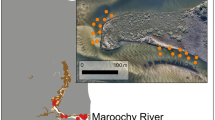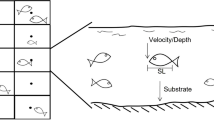Abstract
Habitat features influence the ecological interactions and spatial distribution of fish species. For example, water transparency and macrophyte cover, as well as their interaction, can strongly influence predation risk and mortality. Tethering trials were conducted in Lake St. Pierre (Quebec, Canada) to assess the effects of water transparency and macrophyte cover on the mortality risk of eight abundant fish species; Brown Bullhead (Ameiurus nebulosus), Mooneye (Hiodon tergisus), Emerald Shiner (Notropis atherinoides), Golden Shiner (Notropis crysoleucas), Blacknose Shiner (Notropis heterolepis), Spottail Shiner (Notropis hudsonius), Trout-perch (Percopsis omiscomaycus), and Yellow Perch (Perca flavescens). Kaplan–Meier survival curves showed that mortality risk varied substantially among three groups of species having high, intermediate, or low survival rates. Species with spines appeared to have higher survival rates, consistent with the notion that spines deter predators. Cox regression models showed that mortality risk for six of the eight species was influenced by water transparency or an interaction of transparency with macrophyte cover. Mortality risk was generally greatest at low transparency. Variation in water transparency may generate spatial heterogeneity in fish abundance, either through direct effects, such as local reduction in prey numbers by predation, or indirect effects, such as behavioural avoidance of risky areas by prey.




Similar content being viewed by others
References
Abrahams M, Kattenfeld M (1997) The role of turbidity as a constraint on predator–prey interactions in aquatic environments. Behav Ecol Sociobiol 40:169–174
Adams AJ, Miller RJ, Ebersole JP (2004) Tethers make juvenile surgeonfish (Acanthuridae) vulnerable to attacks by benthic invertebrates. Bull Mar Sci 74:207–211
Aronson RB, Heck KL Jr (1995) Tethering experiments and hypothesis testing in ecology. Mar Ecol Prog Ser 121:307–309
Aronson RB, Heck KL Jr, Valentine JF (2001) Measuring predation with tethering experiments. Mar Ecol Prog Ser 214:311–312
Barrett JC, Grossman JD, Rosenfeld J (1992) Turbidity-induced changes in reactive distance of rainbow trout. Trans Am Fish Soc 121:437–443. doi:10.1577/1548-8659(1992)121<0437:TICIRD>2.3.CO;2
Burnham KP, Anderson DR (2002) Model selection and multimodel inference—a practical information—theoretic approach. Springer, New York
Carvalho LN, Zuanon J, Sazima I (2006) The almost invisible league: crypsis and association between minute fishes and shrimps as a possible defence against visually hunting predators. Neotrop Ichthyol 4:219–224
Clark KL, Ruiz GM, Hines AH (2003) Diel variation in predator abundance, predation risk and prey distribution in shallow-water estuarine habitats. J Exp Mar Biol Ecol 287:37–55
Curran MC, Able KW (1998) The value of tethering fishes (winter flounder and tautog) as a tool for assessing predation rates. Mar Ecol Prog Ser 163:45–51
Dahlgren R, Nieuwenhuyse EV, Litton G (2004) Transparency tube provides reliable water quality measurements. Calif Agric 3:149–153
Danilowicz BS, Sale PF (1999) Relative intensity of predation on the French grunt, Haemulon flavolineatum, during diurnal, dusk, and nocturnal periods on a coral reef. Mar Biol 133:337–343. doi:10.1007/s002270050472
Eklöv P (1992) Group foraging versus solitary foraging in piscivorous predators: the perch, Perca fluviatilis, and pike, Esox lucius, patterns. Anim Behav 44:313–326
Eklöv P (1997) Effects of habitat complexity and prey abundance on the spatial and temporal distributions of perch (Perca fluviatilis) and pike (Esox lucius). Can J Fish Aquat Sci 54:1520–1531. doi:10.1139/cjfas-54-7-1520
Eklöv P, Diehl S (1994) Piscivore efficiency and refuging prey: the importance of predator search mode. Oecologia 98:344–353. doi:10.1007/BF00324223
Frenette J-J, Arts MT, Morin J (2003) Spectral gradients of downwelling light in a fluvial lake (Lake St. Pierre, St-Lawrence River). Aquat Ecol 37:77–85. doi:10.1023/A:1022133530244
Fuiman LA, Magurran AE (1994) Development of predator defences in fishes. Rev Fish Biol Fish 4:145–183. doi:10.1007/BF00044127
Gelman A, Hill J (2007) Data analysis using regression and multilevel/hierarchical models. Cambrige University Press, New York
Gregory RS, Northcote TG (1993) Surface, planktonic, and benthic foraging by juvenile chinook salmon (Oncorhynchus tshawytscha) in turbid laboratory conditions. Can J Fish Aquat Sci 50:233–240. doi:10.1139/f93-026
Ha DS (1996) An investigation of timed-tethering: a method for the study of coral reef piscivory. M.Sc. thesis, University of Windsor, Windsor, Ontario
Heck KL Jr, Orth RJ (2006) Predation in seagrass beds. In: Larkum AWD, Orth RJ, Duarte CM (eds) Seagrasses: biology, ecology, and conservation. Springer, Netherlands, pp 537–550
Hoagland H (1933) Specific nerve impulses from gustatory and tactile receptors in catfish. J Gen Physiol 16:685–693
Hoogland R, Morris D, Tinbergen N (1956) The spines of sticklebacks (Gasterosteus and Pygosteus) as means of defence against predators (Perca and Esox). Behaviour 10:205–236
Jackson DA, Peres-Neto PR, Olden JD (2001) What controls who is where in freshwater fish communities—the roles of biotic, abiotic, and spatial factors. Can J Fish Aquat Sci 58:157–170. doi:10.1139/cjfas-58-1-157
Johnsen S (2001) Hidden in plain sight: the ecology and physiology of organismal transparency. Biol Bull 201:301–318
La Violette N, Fournier D, Dumont P, Mailhot Y (2003) Caractérisation des communautés de poissons et développement d’un indice d’intégrité biotique pour le fleuve Saint-Laurent, 1995–1997. Société de la faune et des parcs du Québec. Direction de la recherche sur la faune, 237 pp
Lima SL, Dill LM (1990) Behavioral decisions made under the risk of predation: a review and prospectus. Can J Zool 68:619–640. doi:10.1139/z90-092
Linehan JE, Gregory RS, Schneider DC (2001) Predation risk of age-0 cod (Gadus) relative to depth and substrate in coastal waters. J Exp Mar Biol Ecol 263:25–44
McIvor CC, Odum WE (1988) Food, predation risk, and microhabitat selection in a marsh fish assemblage. Ecology 69:1341–1351
Minello TJ (1993) Chronographic tethering: a technique for measuring prey survival time and testing predation pressure in aquatic habitats. Mar Ecol Prog Ser 101:99–104
Miner JG, Stein RA (1996) Detection of predators and habitat choice by small bluegills: effects of turbidity and alternative prey. Trans Am Fish Soc 125:97–103. doi:10.1577/1548-8659(1996)125<0097:DOPAHC>2.3.CO;2
Moody RM, Aronson RB (2007) Trophic heterogeneity in salt marshes of the northern Gulf of Mexico. Mar Ecol Prog Ser 331:49–65. doi:10.3354/meps331049
Moody RC, Helland JM, Stein RA (1983) Escape tactics used by bluegills and fathead minnows to avoid predation by tiger muskellunge. Env Biol Fish 8:61–65. doi:10.1007/BF00004947
Murphy BR, Willis DW (1996) Aquatic habitats and measurements. In: Murphy BR, Willis DW (eds) Fisheries techniques. American Fisheries Society, Bethesda, pp 83–120
Nobriga ML, Feyrer F (2007) Shallow-water piscivore-prey dynamics in California’s Sacramento–San Joaquin Delta. San Franc Estuary Watershed Sci 5:1–13
Ostrand KG, Wilde GR (2004) Changes in prairie stream fish assemblages restricted to isolated streambed pools. Trans Am Fish Soc 133:1329–1338. doi:10.1577/T03-193.1
Peterson CH, Black R (1994) An experimentalist’s challenge: when artefacts of intervention interact with treatments. Mar Ecol Prog Ser 111:289–297
Petry P, Bayley PB, Markle DF (2003) Relationships between fish assemblages, macrophytes and environmental gradients in the Amazon River floodplain. J Fish Biol 63:547–569. doi:10.1046/j.1095-8649.2003.00169.x
Pouilly M, Rodríguez MA (2004) Determinism of fish assemblage structure in neotropical floodplain lakes: influence of internal and landscape lake conditions. In: Welcomme R, Petr T (eds) Proceedings of the Second International Symposium on the Management of Large Rivers for Fisheries (LARS2), Volume II. FAO Regional Office for Asia and the Pacific, Bangkok, Thailand, RAP Publication 2004/17, pp 243–265
R Development Core Team (2007) R: a language and environment for statistical computing. R Foundation for Statistical Computing, Vienna, http://www.R-project.org. ISBN 3-900051-07-0
Reid SM, Fox MG, Williams TH (1999) Influence of turbidity on piscivory in largemouth bass (Micropterus salmoides). Can J Fish Aquat Sci 56:1362–1369. doi:10.1139/cjfas-56-8-1362
Rodríguez MA, Lewis WM Jr (1997) Structure of fish assemblages along environmental gradients in floodplain lakes of the Orinoco River. Ecol Monogr 67:109–128
Rowe DM, Denton EJ (1997) The physical basis for reflective communication between fish, with special reference to the horse mackerel, Trachurus trachurus. Phil Trans R Soc Lond B 352:531–549. doi:10.1098/rstb.1997.0037
Ruiz GM, Hines AH, Posey MH (1993) Shallow water as a refuge habitat for fish and crustaceans in non-vegetated estuaries: an example from Chesapeake Bay. Mar Ecol Prog Ser 99:1–16
Ryder RA (1977) The effects of ambient light variations on behavior of yearling, subadult, and adult walleyes (Stizostedion vitreum vitreum). J Fish Res Board Can 34:1481–1491
Sass GG, Gille CM, Hinkle JT, Kitchell JF (2006) Whole-lake influences of littoral structural complexity and prey body morphology on fish predator–prey interactions. Ecol Freshw Fish 15:301–308. doi:10.1111/j.1600-0633.2006.00158.x
Savino JF, Stein RA (1982) Predator–prey interaction between largemouth bass and bluegills as influenced by simulated, submersed vegetation. Trans Am Fish Soc 111:255–266. doi:10.1577/1548-8659(1982)111<255:PIBLBA>2.0.CO;2
Savino JF, Stein RA (1989a) Behavior of fish predators and their prey: habitat choice between open water and dense vegetation. Env Biol Fish 24:287–293. doi:10.1007/BF00001402
Savino JF, Stein RA (1989b) Behavioural interactions between fish predators and their prey: effects of plant density. Anim Behav 37:311–321
Sheaves M (2001) Are there really few piscivorous fishes in shallow estuarine habitats? Mar Ecol Progr Ser 222:279–290. doi:10.3354/meps222279
Sherman ML, Moore PA (2001) Chemical orientation of brown bullheads, Ameiurus nebulosus, under different flow conditions. J Chem Ecol 27:2301–2318. doi:10.1023/A:1012239222761
Skov C, Berg S, Jacobsen L, Jepsen N (2002) Habitat use and foraging success of 0+ pike (Esox lucius L.) in experimental ponds related to prey fish, water transparency and light intensity. Ecol Freshw Fish 11:65–73. doi:10.1034/j.1600-0633.2002.00008.x
Skov C, Nilsson PA, Jacobsen L, Brönmark C (2007) Habitat-choice interactions between pike predators and perch prey depend on water transparency. J Fish Biol 70:298–302. doi:10.1111/j.1095-8649.2006.01255.x
Sweka JA, Hartman KJ (2001) Influence of turbidity on brook trout reactive distance and foraging success. Trans Am Fish Soc 130:138–146. doi:10.1577/1548-8659(2001)130<0138:IOTOBT>2.0.CO;2
Sweka JA, Hartman KJ (2003) Reduction of reactive distance and foraging success in smallmouth bass, Micropterus dolomieu, exposed to elevated turbidity levels. Env Biol Fish 67:341–347. doi:10.1023/A:1025835031366
Tableman M, Kim JS (2004) Survival analysis using S. Chapman & Hall, Florida
Tejerina-Garro FL, Fortin R, Rodríguez MA (1998) Fish community structure in relation to environmental variation in floodplain lakes of the Araguaia River, Amazon Basin. Env Biol Fish 51:399–410. doi:10.1023/A:1007401714671
Therneau TM, Grambsch PM (2000) Modeling survival data: extending the Cox model. Springer, New York
Thetmeyer H, Kils U (1995) To see and not be seen: the visibility of predator and prey with respect to feeding behaviour. Mar Ecol Progr Ser 126:1–8. doi:10.3354/meps126001
Turesson H, Brönmark C (2007) Predator–prey encounter rates in freshwater piscivores: effects of prey density and water transparency. Oecologia 153:281–290. doi:10.1007/s00442-007-0728-9
Utne-Palm AC (2002) Visual feeding of fish in a turbid environment: physical and behavioural aspects. Mar Fresh Behav Physiol 35:111–128
van de Meutter F, De Meester L, Stoks R (2005) Water turbidity affects predator–prey interactions in a fish–damselfly system. Oecologia 144:327–336. doi:10.1007/s00442-005-0050-3
Vandenbyllaardt L, Ward FJ, Braekevelt CR, McIntyre DB (1991) Relationships between turbidity, piscivory, and development of the retina in juvenile walleyes. Trans Am Fish Soc 120:382–390. doi:10.1577/1548-8659(1991)120<0382:RBTPAD>2.3.CO;2
Walters CJ, Juanes R (1993) Recruitment limitation as a consequence of natural selection for use of restricted feeding habitats and predation risk taking by juvenile fishes. Can J Fish Aquat Sci 50:2058–2070. doi:10.1139/f93-229
Zamor RM, Grossman GD (2007) Turbidity affects foraging success of drift-feeding rosyside dace. Trans Am Fish Soc 136:167–176. doi:10.1577/T05-316.1
Acknowledgments
We thank D. Côté, M. Leveillé, and S. Theleme for field assistance. This study was funded by a team grant from le Fonds Québécois de la Recherche sur la Nature et les Technologies (FQRNT) and Discovery Grants awarded by the Natural Sciences and Engineering Research Council of Canada (NSERC) to M.A. Rodríguez and P. Magnan.
Author information
Authors and Affiliations
Corresponding author
Rights and permissions
About this article
Cite this article
Laplante-Albert, KA., Rodríguez, M.A. & Magnan, P. Quantifying habitat-dependent mortality risk in lacustrine fishes by means of tethering trials and survival analyses. Environ Biol Fish 87, 263–273 (2010). https://doi.org/10.1007/s10641-010-9595-z
Received:
Accepted:
Published:
Issue Date:
DOI: https://doi.org/10.1007/s10641-010-9595-z




